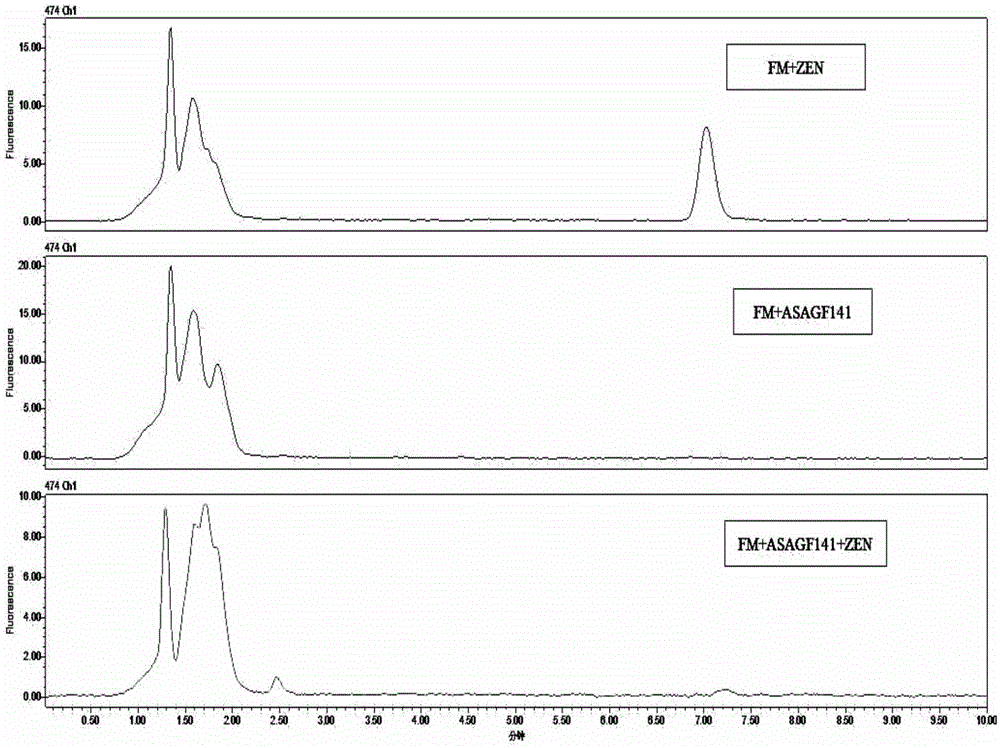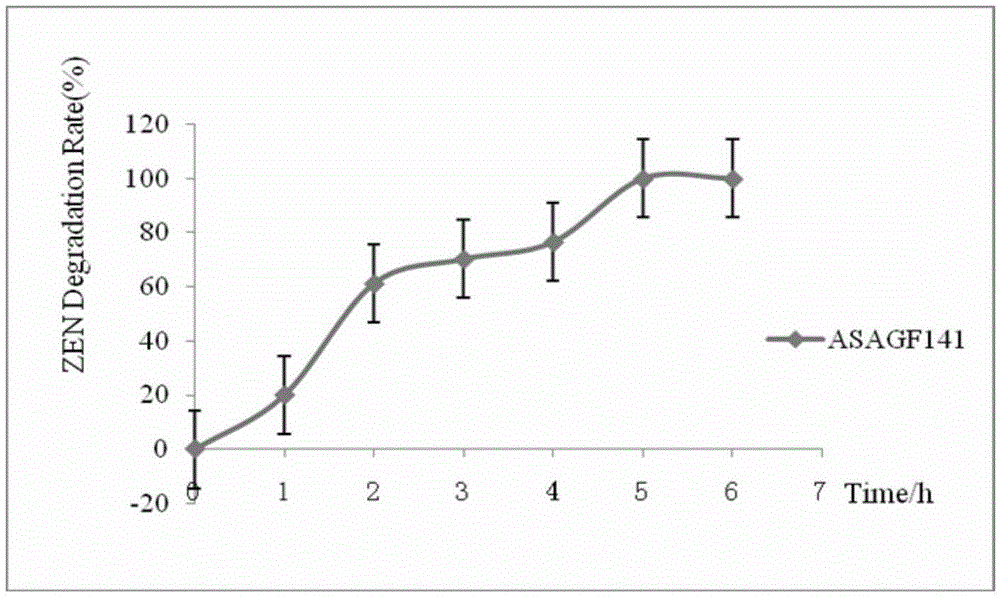Bacillus subtilis for effectively degrading zearalenone and application thereof
A technology for Bacillus subtilis and zearalenone, which is applied to Bacillus subtilis for efficiently degrading zearalenone and its application field, can solve the problems of long degradation time and non-degradation of strains, and achieves bacterial strain safety and production. The effect of low cost of use and improved economic efficiency of animal husbandry
- Summary
- Abstract
- Description
- Claims
- Application Information
AI Technical Summary
Problems solved by technology
Method used
Image
Examples
Embodiment 1
[0029] Example 1 Obtaining and Identification of Bacillus subtilis ASAGF141
[0030] Soil samples were collected from the corn field in Anyang, Henan, and the 96-microwell plate was used as the culture carrier. Firstly, the enrichment culture method of 5 consecutive zearalenone toxin concentration gradients was used to obtain a bacterial suspension capable of degrading zearalenone , then bacterium suspension is spread on LB agar plate (yeast extract 0.5%, tryptone 1%, NaCl 1%, agar powder 1.6%, pH7.2, sterilized at 121 ℃ by dilution coating method with suitable dilution 25min), pick colonies with good growth and separation degree and different colony morphological characteristics and colors, and in LB liquid medium (yeast extract 0.5%, tryptone 1%, NaCl 1% with zearalenone concentration of 10 μg / mL , agar powder 1.6%, pH 7.2, sterilized at 121°C for 25min) to carry out detoxification test, extract residual zearalenone with methanol and perform HPLC detection to verify the degr...
Embodiment 2
[0037] Example 2 Detoxification effect of ASAGF141 in fermentation medium (Fermentation Medium, hereinafter referred to as "FM")
[0038] The activated ASAGF141 was inoculated into 50mL FM liquid medium containing 20μg / mL zearalenone at an inoculum size of 1%, and detoxified culture was carried out under the shaking condition of 220 rpm, and it was taken out regularly and extracted with methanol. Residual zearalenone was extracted, and the remaining content of zearalenone in the final culture was detected by HPLC: the zearalenone in FM was completely degraded, and the ZEN degradation rate of ASAGF141 reached 100% after 6 hours ( See figure 1 ). And draw under the liquid reaction system, the degradation effect figure (degradation curve) of above-mentioned bacterial strain (see figure 2 ).
Embodiment 3
[0039] The preparation of embodiment 3ASAGF141 liquid bacterial agent
[0040] Components and proportions of solid medium: 0.5% yeast extract, 1% tryptone, 1% NaCl, 1.6% agar powder, pH 7.2-7.4, high-temperature steam sterilization at 121°C for 25 minutes.
[0041] Components and proportions of seed medium: yeast extract 0.5%, tryptone 1%, NaCl 1%, pH7.2-7.4, high temperature steam sterilization at 121°C for 25 minutes; fermentation medium components and proportions: ASAGF141: maltose 1%, tryptone 1%, MgSO 4 15mM / L, Tween400.01%, adjust the pH to 7.2.
[0042] Strain activation: ASAGF141 with the preservation number CGMCC No. 9463 was inoculated on solid medium, cultured at 37°C for 2 days, and its zearalenone degradation performance was measured, and then inoculated on the inclined surface of the test tube for later use.
[0043] Seed culture: Pick a single colony from the slant medium and insert it into the seed medium, and cultivate it to the logarithmic phase at 37°C to ...
PUM
 Login to View More
Login to View More Abstract
Description
Claims
Application Information
 Login to View More
Login to View More - R&D
- Intellectual Property
- Life Sciences
- Materials
- Tech Scout
- Unparalleled Data Quality
- Higher Quality Content
- 60% Fewer Hallucinations
Browse by: Latest US Patents, China's latest patents, Technical Efficacy Thesaurus, Application Domain, Technology Topic, Popular Technical Reports.
© 2025 PatSnap. All rights reserved.Legal|Privacy policy|Modern Slavery Act Transparency Statement|Sitemap|About US| Contact US: help@patsnap.com



